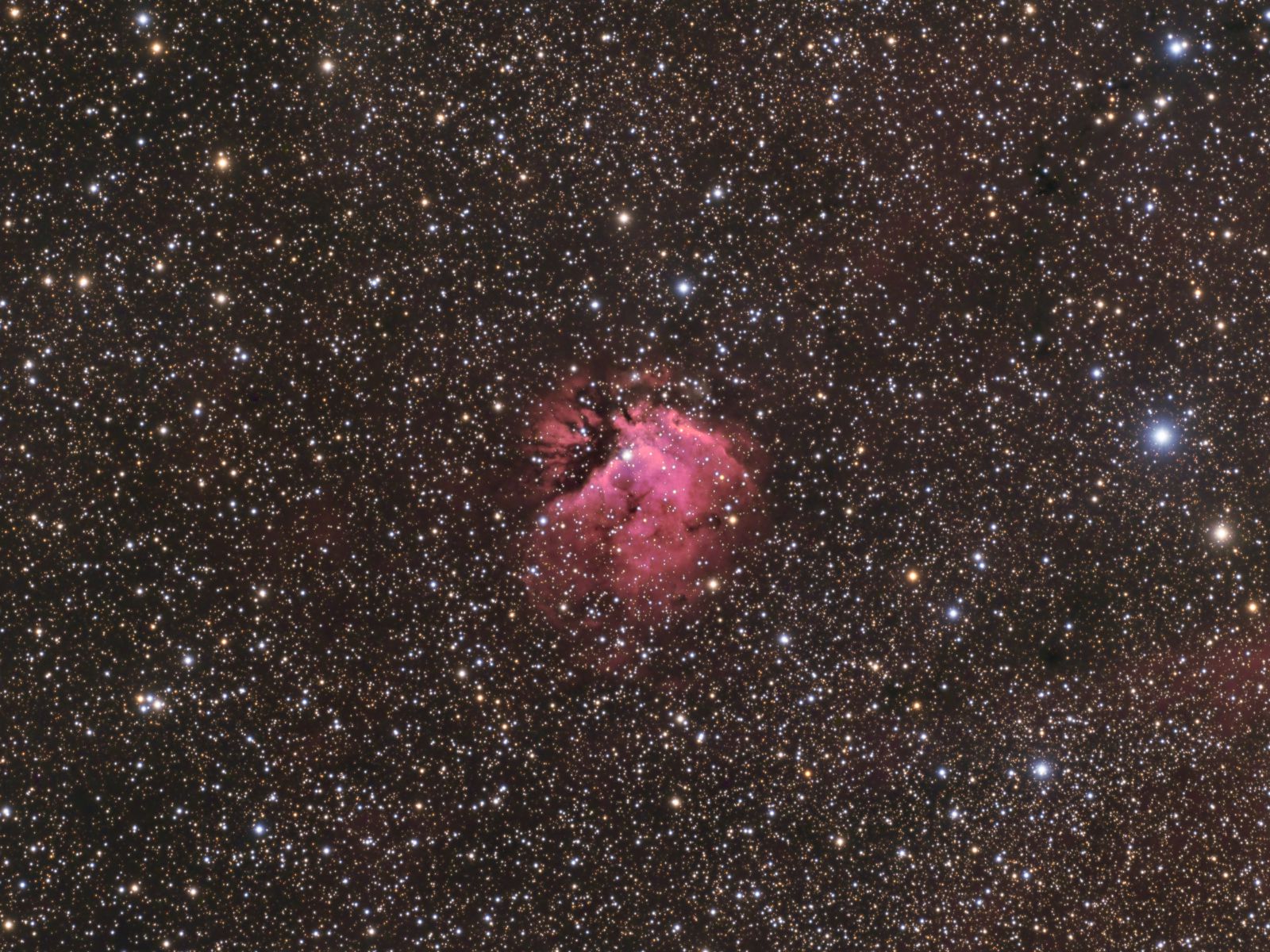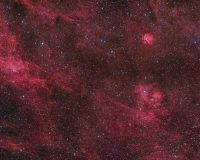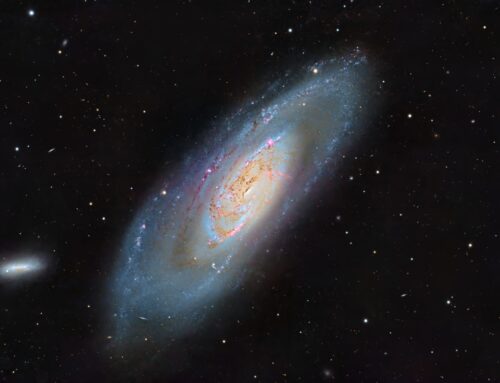Sharpless 2-112
 Click image for full size version
Click image for full size version
August 3, 2020
Sh2-112 lies about 5.600 light years from Earth in Cygnus, the Swan. It’s not far from the North America Nebula, but twice as far away from Earth. This whole area of Cygnus is dominated by the Milky Way and is awash in faint nebulosity, as can be seen in this image. The nebula is illuminated by BD+45 3216, the bright star at its centre, which is about 30x the size of the Sun. This nebula does not seem to be a particularly popular imaging target, though I am not sure why. It is quite beautiful.
 The wide-field view at left shows Sh2-112 (top right) sharing the field with several other objects including Sh2-115 (bottom right). I recently published Hubble Pallette and RGB versions of Sh2-115. While the wide-field view was processed to show all the faintly-glowing gas in the region; the close-up of Sh2-112 above leaves that gas subdued, yet still visible.
The wide-field view at left shows Sh2-112 (top right) sharing the field with several other objects including Sh2-115 (bottom right). I recently published Hubble Pallette and RGB versions of Sh2-115. While the wide-field view was processed to show all the faintly-glowing gas in the region; the close-up of Sh2-112 above leaves that gas subdued, yet still visible.
Tekkies:
Acquisition, focusing, and control of Paramount MX mount, unguided, with TheSkyX. Focus with Optec DirectSync motor and controller. Automation with CCDCommander. Equipment control with PrimaLuce Labs Eagle 3 Pro computer. All pre-processing and processing in PixInsight. Acquired from my SkyShed in Guelph. Average or better transparency and seeing. Data acquired July 23-30, 2020 in a mostly moonless sky.
Luminance and Hydrogen alpha: Sky-Watcher Esprit 150 f/7 refractor and QHY 16200-A camera with Optolong UV/IR and H-alpha filter
Chrominance: Takahashi FSQ-106 ED IV @ f/5 and QHY367C Pro one-shot colour camera with Optolong UV/IR filter
Chrominance: 201 x 5m = 16hr45m
Total: 34hr45m
Data Reduction and Initial Processing
Preprocessing: The WeightedBatchPreProcessing script was used to create Luminance and H-alpha master frames (from the mono camera) and a RGB master frame (from the one-shot colour camera).
Gradient Removal: DBE was applied to Luminance, H-alpha and RGB masters using Subtraction.
Colour
Colour Balancing: Colour was balanced with PhotometricColorCalibration.
Linear Noise Reduction: MultiscaleLinearTransform was used to reduce noise in the background areas, using an internal mask to protect bright structures. Layer settings for threshold, strength and iterations were as follows: Layer 1: 5.0 0.85, 1 iteration; Layer 2: 3.5 0.75, 1 iteration, Layer 3: 2.0, 0.5, 1 iteration.
Stretching: HistogramTransformation was applied to make a pleasing, bright image, with background set to an intensity of approximately 0.10.
Luminance
Deconvolution: A star mask was made from the Luminance master to use as a Local Deringing Support image. A copy of the image was stretched to use as a range mask. Deconvolution was applied (80 iterations, regularized Richardson-Lucy, external PSF made using the PSFImage script; Global dark deringing = 0.02).
Linear Noise Reduction: MultiscaleLinearTransform was used to reduce noise in the background areas of the Luminance-filtered image, using an internal mask to protect bright stars. Layer settings for threshold, strength and iterations: Layer 1: 3.0 0.85, 1 iteration; Layer 2: 2.0, 0.75, 1 iteration; Layer 3: 1.0, 0.25, 1 iteration.
Stretching: HistogramTransformation was applied to make a pleasing, bright image, with background set to an intensity of approximately 0.10.
H-alpha
Deconvolution: A star mask was made from the H-alpha masterto use as a Local Deringing Support image. A copy of the image was stretched to use as a range mask. Deconvolution was applied (80 iterations, regularized Richardson-Lucy, external PSF made using the PSFImage script; Global dark deringing = 0.03).
Linear Noise Reduction: MultiscaleLinearTransform was used to reduce noise in the background areas of the H-alpha image. Layer settings for threshold, strength and iterations: Layer 1: 3.0 0.85, 1 iteration; Layer 2: 2.0, 0.75, 1 iteration; Layer 3: 1.0, 0.25, 1 iteration.
Stretching: HistogramTransformation was applied to the Ha to make a pleasing, bright image, with background set to an intensity of approximately 0.10.
Combining Luminance, Colour and H-Alpha Images
Make LRGB: The Luminance was applied to the RGB image using LRGBCombination with default settings.
Make HaLRGB: PixelMath was used to add Ha to the LRGB image, using the following expressions for the R, G and B channels:
R: max($T[0], 1.1*Ha)
G: $T[1]
B: iif($T[0]<Ha, $T[2] + 0.08*Ha, $T[2])
Additional Processing
Nonlinear Noise Reduction: TGVDenoise was used in L*a*b* mode to reduce noise with a mask used to target the background areas and protect the stars and nebula (max. 1,000 iterations and convergence selected for both lightness and chrominance).
Contrast Enhancement: LocalHistogramEqualization was applied with a scale of 50 (max contrast 1.5, strength 0.3, 1 iteration), followed by a scale of 150 (max contrast 1.5, strength 0.5, 1 iteration).
Sharpening: MultiscaleLinearTransform was used to sharpen Layers 2 and 3 with strengths of 0.05 and 0.03, respectively. A mask was used to select only bright nebular features for sharpening.
Final Steps: Background and star brightness, contrast, and colour saturation were adjusted in several iterations using CurvesTransformation with masks as required. The DarkStructureEnhance script was run with default settings on a clone of the image. The result was blended back into the HaLRGB image with PixelMath using a mask to limit the replacement to the centre of the nebula. ICCProfileTransformation (sRGB IEC61966-2.1; Relative Colorimetric with black point compensation) was applied prior to saving in jpg format.






Leave A Comment